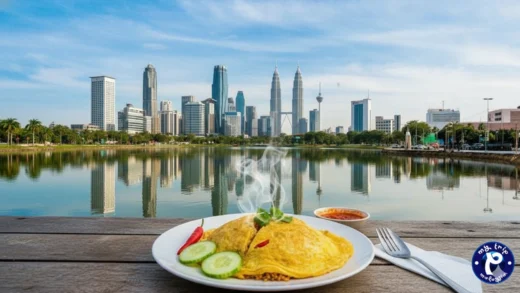Binjai

Introduction
Binjai, scientifically known as Mangifera caesia, stands as one of Malaysia’s most distinctive indigenous fruits—celebrated for its aromatic intensity, bold tanginess, and deep roots in local culinary heritage. Long enjoyed across rural and coastal communities, the fruit has evolved from a humble village favourite into a contemporary culinary highlight embraced by chefs, food storytellers, and agro-tourism innovators.
Its strong flavour profile, heritage-rich identity, and rising relevance in modern gastronomy position Binjai as a compelling symbol of Malaysia’s biodiversity and cultural continuity. As consumer interest increasingly shifts toward authentic, origin-driven ingredients, Binjai offers unique value both locally and regionally.
Origin
Binjai is native to the rainforests of maritime Southeast Asia, primarily the Malay Peninsula, Sumatra, and Borneo. A member of the Anacardiaceae family—shared with mangoes and cashews—this fruit has long been cultivated by indigenous and rural communities for its culinary versatility and environmental resilience.
Historical records and oral traditions suggest that Binjai spread across Malaysia, Indonesia, Brunei, and southern Thailand through local trade networks and migratory patterns. Today, the species remains an important part of regional agroforestry systems, supporting biodiversity and contributing to smallholder agricultural livelihoods.
Category
| Scientific Name | Family | Category | Type (Seasonality) |
|---|---|---|---|
| Mangifera caesia | Anacardiaceae | Tropical Indigenous Fruit | Seasonal (June–September) |
Appearance
Binjai is elongated and oval, typically measuring 10–20 cm in length. The rind is thick, slightly rough, and brownish-green, transitioning to monotone yellow hues when fully ripe. Inside, the fruit reveals soft, creamy-white flesh that can be fibrous depending on the variety and ripeness level. A significant central seed anchors the fruit, similar to mango species. Its visual identity is shaped by the contrast between its rustic exterior and its aromatic, flavour-rich interior.
Popular Varieties
| Variety | Local Name | Distinctive Features | Region of Prominence |
|---|---|---|---|
| Standard Binjai | Binjai Kampung | High acidity, strong aroma | Kedah, Perak |
| White Binjai | Binjai Putih | Mild sourness, soft texture | Kelantan, Terengganu |
| Wild Binjai | Binjai Hutan | Smaller, sharper flavour | Sabah, Sarawak |
| Sweet Binjai | Binjai Manis | Balanced sweetness | Johor, Pahang |
Preparation
- Fresh: Enjoyed raw with salt, sugar, or chili powder.
- Snacks: Commonly pickled (jeruk), fermented lightly, or turned into fruit condiments.
- Desserts: Used in sorbets, jellies, and modern tropical desserts.
- Traditional Cuisine: Adds depth to sambal belacan, kerabu, ulam, and sour-based dishes.
- Beverages: Featured in juices, smoothies, and artisanal fruit drinks.
Equipment
- Paring knife
- Cutting board
- Peeler (optional)
- Spoon or fruit scooper
- Blender (for beverages and desserts)
Taste
Binjai delivers a striking combination of tanginess and subtle sweetness. Its flavour is often described as bold, refreshing, and layered—with citrus-like notes and floral undertones. Ripeness influences the acidity, allowing for a spectrum ranging from sharp and vibrant to soft and mildly sweet.
Texture
The flesh is soft, juicy, and sometimes fibrous. When perfectly ripe, Binjai offers a creamy, almost spoonable texture complemented by a pleasant pulpy mouthfeel. These characteristics make it suitable for both fresh consumption and culinary applications requiring texture contrast.
Aroma
Binjai is known for its strong, perfumed aroma that combines ripe mango, tropical citrus, and faint floral tones. Its scent is pronounced even from a distance, often indicating the fruit’s maturity and quality.
Cultural Significance
Across Malaysia, Binjai is anchored in cultural memory and traditional practices. It appears in kampung recipes, family gatherings, seasonal celebrations, and communal cooking sessions. The fruit carries a sense of nostalgia, symbolising rural life, shared experiences, and intergenerational culinary knowledge.
In today’s culinary landscape, Binjai plays an important role in heritage preservation and food innovation, offering chefs a culturally resonant ingredient with high storytelling value.
Regional Cultivation
| State/Region | Famous For | Harvest Period |
|---|---|---|
| Kedah | Abundant kampung produce | June–August |
| Perak | Balanced hot-sour flavours | July–September |
| Kelantan | Popular Binjai Putih | June–July |
| Terengganu | High seasonal demand | June–August |
| Sabah | Wild forest varieties | May–July |
| Sarawak | Small-scale cultivation | July–September |
Social Context
Binjai forms part of Malaysia’s vibrant fruit culture, often sold at wet markets, roadside stalls, and seasonal pop-up stands. Communities enjoy the fruit during peak season, preparing sambal, pickles, and fruit platters together. In urban centres, Binjai has grown into a niche favourite within cafes, artisanal beverage outlets, and modern Malaysian restaurants reimagining local ingredients.
Nutritional Information (per 100g)
| Nutrient | Amount |
|---|---|
| Calories | ~65 kcal |
| Carbohydrates | 15–17 g |
| Protein | 0.5–1 g |
| Fat | 0.3 g |
| Fiber | 2–3 g |
| Vitamins | Vitamin C, A, B-complex |
| Minerals | Potassium, Calcium, Iron, Magnesium |
Health Benefits
- Supports immune function through vitamin C
- Promotes digestive wellness due to fiber content
- Offers antioxidants that benefit skin health
- Contributes to hydration and natural energy levels
- Provides essential minerals for metabolic function
- Helps regulate fluid balance with potassium
Dietary Restrictions
- Individuals sensitive to acidic foods should moderate intake
- People with diabetes should limit portions due to natural sugars
- Those experiencing gastritis may find highly sour fruits discomforting
- Unripe fruit may cause mild digestive irritation
Allergens
- May trigger cross-reactive responses in individuals allergic to mango, cashew, or related Anacardiaceae plants
- Skin contact may cause mild irritation in particularly sensitive individuals
Cost
- Standard Binjai: RM8–RM15 per kg
- Premium Binjai / Binjai Putih: RM12–RM20 per kg
- Wild Binjai: RM5–RM12 per kg
Prices depend on region, seasonality, and supply volume.
Production & Export
Binjai is primarily consumed domestically, with niche exports to Singapore, Brunei, and select Asian specialty markets. Although not yet a major commercial export, the fruit presents emerging opportunities in:
- Frozen pulp and concentrate products
- Artisanal condiments and beverages
- Natural flavour extracts
- Branding initiatives centred on indigenous Malaysian produce
- Agro-tourism attractions and farm-retail experiences
As global interest grows around origin-based food narratives and exotic tropical fruits, Binjai holds considerable potential for market expansion and value-added innovation.
Symbolism
Binjai embodies values of heritage, authenticity, shared identity, and agricultural abundance. Its presence in traditional cuisine reflects Malaysia’s commitment to preserving cultural memory and celebrating natural richness. As Malaysia continues to strengthen its culinary identity on the international stage, Binjai stands as a meaningful representation of the country’s biodiversity, tradition, and evolving food culture.





Comments are closed.